What to do if you Find a Stray or Feral Cat
Feral cats are cats that live on their own in the wild because they were abandoned by their owner, lost their way from their original home, or were born to a feral or stray mother cat. Feral cats live ‘on the streets’ and have had little to no human contact. There are varying degrees of being feral. A totally-feral cat has had no human contact or abusive human contact, will be extremely frightened of people, and will avoid people at all costs.
A semi-feral cat is one who has had limited human contact in the past, and may come near people or may even allow themselves to be fed but will still be very timid and skittish near humans. A slightly-feral cat is one who previously was a pet and either got lost or was abandoned. This type of cat will revert to feral behaviours once outside, but has had positive human encounters and therefore may approach people or allow themselves to be petted.
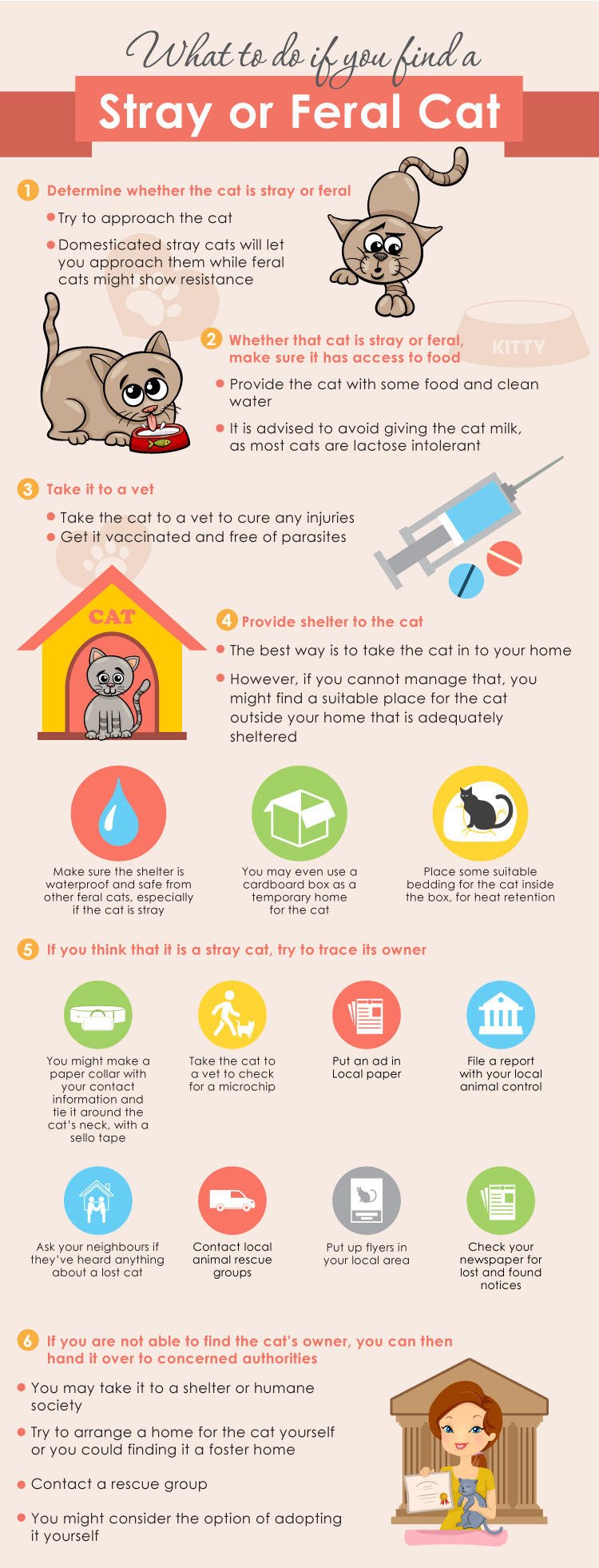
Why are there feral cats?
Feral cats are abandoned or lost domesticated cats, or are kittens born to those unspayed/unneutered, abandoned or lost domesticated cats. Unspayed mothers will have litter after litter of feral kittens, which will grow up and multiply the problem if they aren’t spayed by watchful cat lovers.
It is estimated that in a ten year time period a single female cat, between her litters and the litters of her offspring, can extend the population by over a quarter of a million cats! Thus we have come to the situation we face today – overpopulation of cats. Millions of these animals are euthanized throughout the world when there is no person available to adopt them.
Many of these animals are healthy and adoptable, but there is no one to care for them. And the ‘homeless’ cats that wander our streets spread disease and usually lead short lives and have slow painful deaths.
How do feral cats survive?
Cats are skilled survivors and adaptable to many environments. If left on their own in the wild, they will find a way to live, but not necessarily thrive. A feral cat without any human intervention usually leads a very harsh and short life (however if unspayed/unneutered they will most likely reproduce at least once during this short lifetime). A majority of them die at an early age of disease, malnutrition, or become the victims of malevolent humans or animals. During their time alive they will usually band together in a feral colony for survival. This colony will work as a team to hunt and protect each other.
What can be done to help decrease the number of feral cats?
First, owners must be convinced that it is unacceptable to abandon their animals. Many owners feel that cats can survive quite well on their own, and thus when they are tired of them or can no longer take care of them, simply drop them off somewhere or leave them behind when they move. These cats will revert to feral behaviours, a feral lifestyle, and if not spayed or neutered, will reproduce and contribute to the overpopulation problem.
Second, all cats should be spayed or neutered. Even if you have an 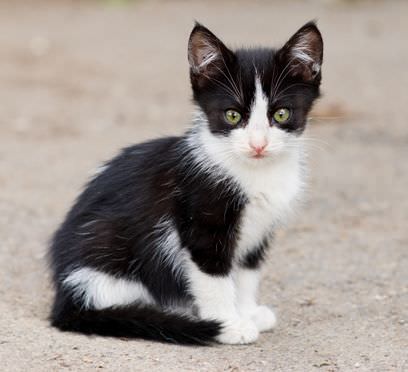 lower chance of behavioural indoor-only cat that never gets outside. Spayed and neutered cats have a reduced risk of hormonally-related illnesses and they have a problems, so there is never a good reason not to spay or neuter. If you think your cat will miss out on the wonders of mothering, there are plenty of kittens to adopt at shelters, and female cats often make great foster mums.
lower chance of behavioural indoor-only cat that never gets outside. Spayed and neutered cats have a reduced risk of hormonally-related illnesses and they have a problems, so there is never a good reason not to spay or neuter. If you think your cat will miss out on the wonders of mothering, there are plenty of kittens to adopt at shelters, and female cats often make great foster mums.
Third, we need to try to control feral cat breeding and keep population in check. In the past, feral cats that were trapped or spotted were immediately euthanized. However today most activists and experts go with the (TNR) approach which stands for Trap-Neuter-Release/Rescue. This policy is working wonders and is greatly reducing the number of cats euthanized in communities where concerned cat lovers monitor feral cat colonies and abide by the TNR method.
What to do with ferals in your area
If you see a feral cat or a feral cat colony around your home it’s a good idea to find a way to trap those cats for at minimum a trip to the vet and a spay or neuter. Depending on the feral state of the cat, how you trap the cat will differ. If you have a totally feral cat around, you may want to try to gain the cat’s trust before trapping. Food is usually the best motivator for feral cats. You might consider putting food out for the cat at the same time every day. Watch from a distance to see if the cat notices and eats the food. If he/she is taking your food, continue putting it out at the same time every day to develop a routine for the cat.
After a while you can wait near the food so the cat can see you and associate you with the food or, if you’re lucky, seek contact with you. Once the cat is comfortable in your presence you can start trying to approach the animal. Make sure you always move slowly, and talk slowly and softly around a feral animal. Always listen to what the cat is ‘saying’ with the position of its body, ears, tail and whiskers, and never rush the animal into contact. If he/she ever gets frightened or angry, don’t push it. Eventually you can put a humane trap out for the animal. You can usually purchase or borrow one from your local humane society or shelter.
Once you have trapped the animal, you can take him/her to the vet for a full check-up. It will be a good idea to have the cat tested for FeLV, FIV, FIP, fleas, mites and other diseases. Once the cat is back from the vet and is medically taken care of you must decide whether to rescue or release the animal.
Socialising feral cats
Socialising a feral cat can be a demanding, yet rewarding experience. The outcome of how well the feral cat integrates will come down to several factors that include how old he/she is, how feral they are, and also your own personality and patience. Remember, this feral can has spent a long time without any sort of human contact, however if you can work together to build a bond you may consider keeping the cat as a pet.
If the cat is too wild to be a housecat and you release the cat, you will need to monitor the cat and its colony. This will give the cat the best chance possible for a long and happy existence (especially if the cat is deemed unadoptable). Since the cat trusted you to give him/her food before the trapping, you should continue to put food and water out. You also should make a few shelter areas outside so that the animal can have a dry and warm place in which to hide from harsh weather.
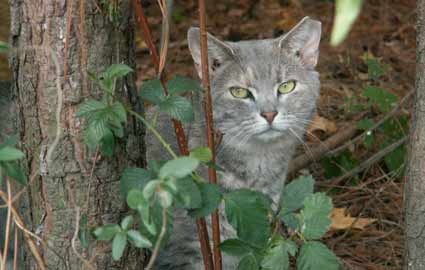
Also, once one cat in the colony gains your trust, you may be able to trap-neuter-and release other animals in the colony. A colony of feral cats that are monitored by humans can live long and happy lives. But you will want to make sure that you have all the cats (or as many as you can) in the colony spayed or neutered, that you feed and water them, that you provide shelter for them, and that you watch them to see if any get ill or hurt and need to go back to the vet. If you are planning to take care of a feral colony, you may want to search for and contact a feral cat network in your area who can give you tips and assistance.
Remember that although it would be great if all cats could live in a big house with lots of love and attention, there are more cats than homes, and some cats will never be socialised well enough to be pets. So with some cats, we need to compromise and do what is best for them, and that isn’t putting them to sleep. For some cats, the best case scenario is living in a home, and for others it is living in a monitored cat colony. But either way, if we can keep up efforts to spay and neuter as many cats as possible and slow the population of feral cats in the first place, we have accomplished a wonderful goal and saved many lives!
Monitoring feral cats
Establishing and monitoring a feral cat colony is not an easy job, but it is an extremely rewarding one. Feral cat care takes time, patience, resources, and involves more than just feeding and watering the cats. Such care will involve trapping, altering, monitoring, and providing veterinary care, in addition to daily feeding and watering. There are three main things involved in setting up a feral cat colony – constructing a shelter, constructing a feeding station, and carefully monitoring the colony.
Constructing a Shelter: The first step is to create a shelter(s) that the cats can use to stay warm, dry, sleep, and take shelter from the elements. You can create the shelter out of anything ranging from a cardboard box, to a home-made wooden box to a small doghouse. The important thing to keep in mind is that the shelter should be large enough to allow 3-5 cats to comfortably huddle together yet small enough that the shelter will trap the cats’ body heat to help the cats stay warm. A good approximate size is 2 ft long by 3 ft wide by about 2 ft high. It will also be important that the shelter is elevated so it can stay high and dry.
You can do this by placing the shelter on concrete blocks, bricks or wood pallets. Also bear in mind that if you are building a shelter out of cardboard that you will need to cover the outside of the box with plastic or some other waterproof material. And lastly your shelter will need a door! The doorway should be large enough to let in a large cat yet small enough to keep out dogs and other animals. You might also want to add in a flap or lay a slanted piece of wood in front of the doorway to help keep the cold, wind and elements out while allowing the cats to come and go as they please.
Constructing a Feeding Station: You will want to create a separate feeding station from the sleeping area. This way even if the water gets spilled, if there is a fight over food, or if another animal gets into the food, the cats will still have a safe shelter to return to. Unlike the shelter, the feeding station should be a little more open. To do this you can create a covered station that is fully open on at least 1 or 2 sides. This way the cats can still feel safe and map out escape routes while feeding. Just like the shelter, the feeding station should be waterproof and be raised off the ground. You should try to bring fresh food and water to the cats at the same time every day. Cats love schedules so they will get used to your comings and goings especially if you stick to a schedule
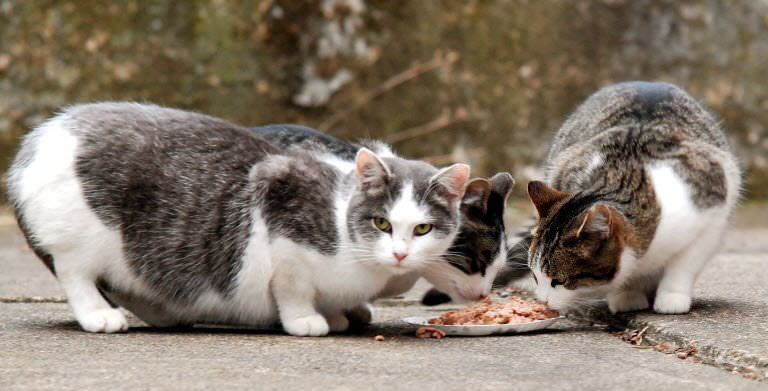
Monitoring the Colony: One of the most important parts of caring for your colony is to monitor the cats on a regular basis and provide them with proper veterinary care. When a new cat enters the colony he/she should be trapped and taken to see the vet. While at the vet’s he/she should receive an initial exam, get tested for parasites and feline diseases, receive all vaccinations and be spayed or neutered. You might even consider putting some type of ID on each cat such as a microchip or ear tag to identify the cat as part of the colony with you as a contact person if any of the cats wander off or gets hurt away from the colony. After that you can decide whether or not that cat is suitable for adoption, socialisation or should be returned to the colony. Cats who remain as part of the colony should be monitored daily for any problems or illnesses. You might even want to consider keeping a notebook to keep track of the cats in your colony and their medical history or socialization process.
If you do plan to set up a feral cat colony you may want to talk to local vets, shelters or pet stores to see if you can buy food at bulk rates or receive a discount on all vet bills for cats in your colony.
Winterising feral cats
Winter poses a few special problems for feral cat caretakers to deal with.
- Increased Precipitation. Before the winter weather arrives you should inspect all shelters and food stations to make sure that they are in good shape to protect the cats from rain, snow, cold temperatures and high winds. To do this, make sure the sides and walls of all shelters and feeding stations are properly sealed and covered and that the roofs are waterproof and sealed from leaks. And make sure that all shelters and stations are properly elevated to protect the cats from severe rain or flooding.
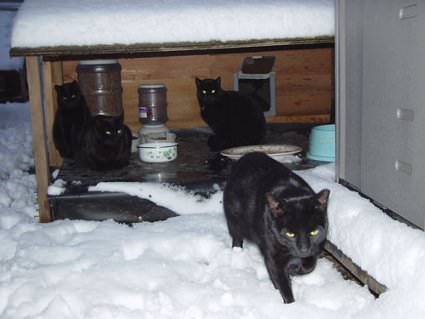
- Keeping Food and Water Fresh. In extremely cold temperatures water may freeze quickly. Thus you may want to bring warm water when you visit the feeding station. This way it will take long
er to freeze. Similarly you may want to bring warm moist food if you give the cats wet food as an occasional treat. Or you may want to only feed dry food during the winter months if freezing will be a problem.
- Snowstorms. If you live in a particularly snowy area you may need to elevate the shelters extra high and provide a ramp for the cats to get into and out of the shelters. You may also need to dig out a daily path to the shelters in snowstorms.
[simple-social-share]










